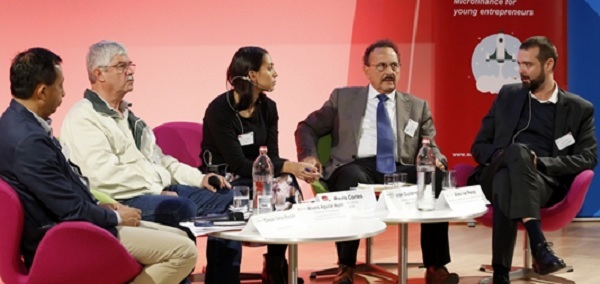
While the European Microfinance Week has just started, the 41st session of Midi de la microfinance addressing Financial Inclusion organised by ADA was an opportunity to discuss the role of microfinance in accessing housing.
To debate this, Banque de Luxembourg hosted the three finalist institutions of the 2017 European Microfinance Award, as well as the Director of the REDCAMIF Microfinance Network in Central America, a long-standing partner of ADA.
Although microfinance has the initial mission of meeting the financing needs of the productive and commercial activities of the poorest populations, it is clear that needs have changed. Even today, almost 50% of the world's population does not have enough to live, while access to housing is considered a fundamental human right. Clients now need a home not only to pursue a business that generates income, but also to live with their family. Most often, it is the same roof.
Since traditional financial institutions are struggling to meet these personal needs, microfinance has taken over to position itself on this segment of the population. Thus, many actors of inclusive finance such as banks, NGOs or microfinance institutions develop new financial and non-financial products, adapted to the needs of local populations.
Invited to testify to this momentum, the three microfinance institutions - First MicroFinance Bank in Afghanistan, Mibanco in Peru and Cooperativa de Ahorro y Prestamo Tosepantomin in Mexico - delivered their responses on the occasion of this meeting.
According to them, everything begins with the demand on the ground: "The demand exists; there is a real local need that drives us to create products for housing, either because the context is unfavourable, or because our customers do not have sufficient financial resources". According to Alex Perez, Director of Sustainable Strategy and Customer Analysis at The First MicroFinance Bank in Afghanistan, "The products we offer are intended to generate a positive social impact, improve the quality of life of our customers. Habitation is an integral part of our business model". For Alex Perez, "20% of our loan portfolio is dedicated to improving or renovating existing housing. It is consequent!".
Cesar Bazan, product manager at Mibanco in Peru, said it is essential to create business alliances around the product, because materials are so expensive. "We have developed a very specific methodology with all the players involved in construction: we offer complementary tools to the product, such as insurance to protect the micro-entrepreneur's investment."
Alvaro Ayón, President of the Board of Directors of the Cooperativa de Ahorro y Prestamo Tosepantomin in Mexico, offers eco-friendly products, such as rainwater recovery techniques and the installation of solar panels.
According to Alex Perez, the difficulty is to design a product, even though there is not enough information on the market: where to build, how, to whom and with what materials, this is the initial question that everyone must answer before starting.
"It's risky to evaluate the success of a product when you do not have an existing benchmark," continued Alex Perez. "We must be well surrounded, rely on partners in the field. In addition to our products, we also offer our customers technical support through a network of partners", added Alex Perez, to advise them in their choice of materials for example. The same goes for the Mexican cooperative Tosepantomin, which has collaborated with a cooperative that supplies its customers with low-cost construction materials.
This is an opportunity for REDCAMIF to recall the support they have received from the Luxembourg organisation ADA for many years already, with which they have set up a pilot project in Latin America with 11 other institutions, which has made it possible to develop 6 products, each adapted to the needs of local populations.
In the end, this noon event was the opportunity to tackle a new approach to inclusive finance: more and more, financial institutions are exploring new solutions to meet the personal and professional needs of populations excluded from traditional banking channels.








